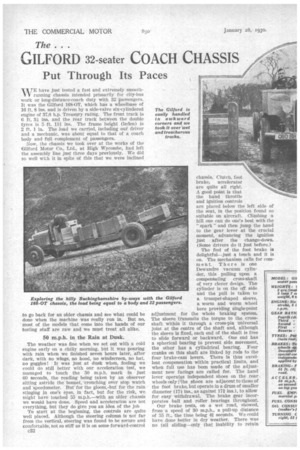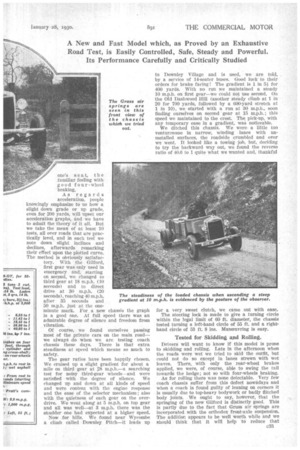The . . .
Page 54

Page 55

Page 56

If you've noticed an error in this article please click here to report it so we can fix it.
GILFORD 32-seater COACH CHASSIS
Put Through Its Paces
A New and Fast Model which, as Proved by an Exhaustive Road Test, is Easily Controlled, Safe, Steady and Powerful. Its Performance Carefully and Critically Studied
TE have just tested a fast and extremely smooth
V running chassis intended primarily for city-bus work or long-distance-coach duty with 32 passengers. It was the Gifford 168-OT, which has a wheelbase of 16 ft. 8 ins, and is driven by a side-valve six-cylindered engine of 37.6 h.p. Treasury rating. The front track is 6 ft. 31 ins, and the rear track between the double tyres is 5 ft. 10 ins. The frame height (laden) is 2 ft. 1 in. The load we carried, including out; driver and a mechanic, was about equal to that of a coach body and full complement of passengers.
Now, the chassis we took over at the works of the Gifford Motor Co., Ltd., at High Wycombe, had left the assembly line just three days previously. We did so well with it in spite of this that we were inclined
to go back for an older chassis and see what could be done when the machine was really run in. But no, most of the models that come into the hands of our testing staff are raw and we must treat all alike.
50 m.p.h. in the Rain at Dusk.
The weather was fine when we set out with a cold engine early on a chilly morning, but it was pouring with rain when we finished seven hours later, after dark, with no wings, no hood, no windscreen, no hat, no goggles! It was just at dusk when, feeling we could do still better with our acceleration test, we managed to touch the 50 m.p.h. mark in just 60 seconds, the reading being taken by an observer sitting astride the bonnet, crouching over stop watch and speedometer. But for the gloom,-but for the rain stinging in one's eyes, in fact, but for the risk, we might have touched 55 m.p.h.—with an older chassis we would have done. Speed and acceleration are not everything, but they do give you an idea of the job
To start at the beginning, the controls are quite well placed. Although the steering column is not far from the vertical, steering was found tobe secure and comfortable, not so stiff as it is on some forward-control
c32 chassis. Clutch, foot.
brake, accelerator are quite all right. A good point is that the hand throttle and ignition controls are placed below the left side of the seat, in the position found so suitable on aircraft. Climbing a kill one can do one's best with the " spark " and then jump the hand to the gear lever at the crucial moment, advancing the ignition just after the change-down. (Some drivers do it just before.) The feel of the foot brake is delightful—just a touch and it is on. The mechanism calls for com m e n t. There is one Dewandre vacuum cylinder, this pulling upon a compensating cross-shaft of very clever design. The cylinder is on the off side and the pull is taken to a trumpet-shaped sleeve, a worm and worm wheel here providing single-point adjustment for the whole braking system. The sleeve transmits the torque to the crossshaft within it through a cross-pin universal joint at the centre of the shaft and, although the sleeve is fixed, each end of the shaft is free to slide forward or backward. One end has a spherical bearing to prevent side movement, the other has a cylindrical bearing. Four cranks on this shaft are linked by rods to the four brake-cam levers. There is thus excellent compensation within practical limits, and when full use has been made of the adjustment new facings are called for. The hand lever operates independent shoes on the rear wheels only ; the shoes are adjacent to those of the foot brake, but operate in a drum of smaller diameter (17i ins., as against 171 ins.), to allow for easy withdrawal. The brake gear incorporates ball and roller bearings throughout.
Our brake tests, on a wet road, showed, from a speed of 30 m.p.h., a pull-up distance of 55 ft., the time being 41 seconds. We could have done better in dry weather. There was no tail sliding—only that inability to retain
one's seat, the familiar feeling with good four-wheel braking.
As regards acceleration, people knowingly emphasize to us how a slight down grade or up grade, even for 200 yards, will upset our acceleration graphs, and we have to admit the theory of it all. But we take the mean of at least 10 tests, all over roads that are practically level., and in each tesf we note down slight inclines and declines, afterwards remarking their effect upon the plotted curve. The method is obviously satisfactory. With the Gifford, first gear was only used in emergency and, starting on. second, we changed to third gear at 18 m.p.h. (10 seconds) and to direct drive at 30 m.p.h. (20 seconds), reaching 40 m.p.h. after 35 seconds and 59 m.p.h. just at the oneminute mark. For a new chassis the graph is a good one. At full speed there Was an admirable degree of silence and freedom from . vibration.
Of course, we found ourselves passing most Of the private cars on the main road— we alwayS do when we are testing coach chassis these days. There is that extra steadiness at speed which means so much to safety. •
The gear ratios have been happily chosen. We cruised up a slight gradient for about a mile on third gear at 28 m.p.h.—a searching test for noisy third-gear wheels and were satisfied with the degree of silence. We changed up and down at all kinds of speed and were content with the engine response and the ease of the selector mechanism; also with the quietness of each gear on the overdrive. We went along at 5 m.p.h. on top gear and all was well—at 3 m.p.h. there was the shudder one had expected at a higher speed.
Now for hills. We found near Wycombe a climb called Downley Pitch—it leads up to Downley Village and is used, we are told, by a service of 14-seater buses. Good luck to their orders for brake facing! The gradient is 1 in 5i for 400 yards. With no run we maintained a steady 10 m.p.h. on first gear—we could not use second. On the Old Dashwood Hill (another steady climb at 1 in 20 for 700 yards, followed by a 600-yard stretch at 1 in 10), we started with a run at 30 m.p.h., soon finding ourselves on. second gear at 15 m.p.h.; this speed we maintained to the crest. The pick-up, with any temporary ease in a gradient, was noticeable.
We ditched this chassis. We were a little too venturesome in narrow, winding lanes with unmetalled surfaces, the roadside crumbled and over we went. it looked like a towing job, but, deciding to try the backward way out, we found the revere ratio of 40.6 to 1 quite what we wanted and, thankful for a very sweet clutch, we came out with ease. The steering lock is made to give a turning circle within the legal limit of 60 ft. diameter, the chassis tested turning a left-hand circle of 55 ft. and a righthand circle of 53 ft. 8 ins. Manoeuvring is easy.
Tested for Skidding and Rolling.
Drivers will want to know if this model is prone to skidding and rolling. Late In the afternoon when the roads were wet we tried to skid the outfit, but could not do so except in lanes strewn with wet leaves. There, with only the rear-wheel brakes applied, we were, of course, able to swing the tall towards the hedge; not so with four-wheels braking. As for rolling there was none detectable. Very few coach chassis suffer from this defect nowadays and when a coach is found guilty of leaning on corners it is usually due to top-heavy bodywork or badly ditched body joints. We ought to say, however, that the springing of the new Gilford is distinctly good. This is partly due to the fact that Grus,s air springs are incorporated with the orthodox front-axle suspension. The addition appears to be well worth white and we should think that it will help to reduce that fore-and-aft chassis whip for which most bodybuilders allow by suspending the forward-control cab from the roof canopy, or separating it from the main bodywork. All spring shackles have Silentbloc bearings.
We did not take the chassis on to field tracks, for the country was so saturated and the ground so soft—anyway, the long-distance coach is a highway vehicle.
We finished the day with a fuel consumption test. Detaching altogether the vacuum-tank supply system, we emptied the carburetter and connected up a test tank containing a measured gallon. With this we rap for 9.9 miles on give-and-take main roads before the gallon was exhausted. The figure is reasonably good—considering that the chassis was new, it is quite good. What else would our readers ask about the 168-0T? The company has been putting in a lot of time on the study of cylinder-head contours and finds that one with a steep transverse section above the axis of the piston gives comparatively good readings. By the way, Alcyl central chassis lubrication is provided. The new model should prove an excellent seller. The Gilford company, has done very well in a comparatively short time, and looks like doing better.












































































































